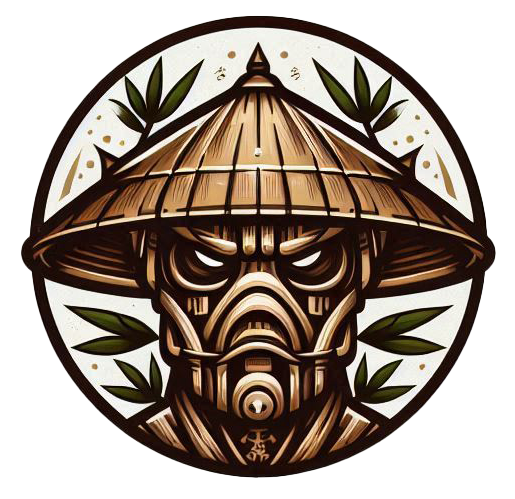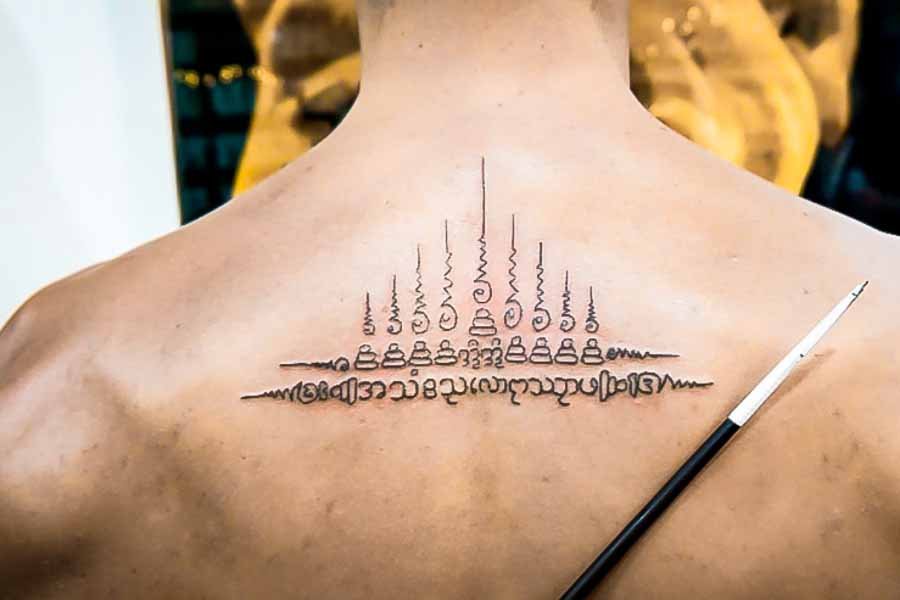The History of Sak Yant Hand Poke Bamboo Needle Tattoos Started in Thailand around 2003

Today in Thailand you will find almost every Tattoo Shop providing what are referred to as Traditional Thai Bamboo Needle Tattoos. The reality is, this whole ‘style’ of tattooing is a modern, tourist driven development. There was no Tradition of using Bamboo Needles to make Tattoos in Thailand …. not until Tourist started requesting them.
Find out the invented fake history Sak Yant Bamboo Needle Tattoo for Tourists …. then avoid it .. If you are wanting an Authentic Traditional Thai Spiritual Sak Yant Experience
The Real Traditional Thai Tattoo was and still is called a Sak Yant. A spiritual and Magical Talisman applied by a Sak Yant Master, using the Hand Poke method. The Tourist Bamboo Needle Tattoo is NOT a Sak Yant – they are meaningless and disrespectful copies done by tattoo parlors for profit
The Sak Yants have almost always been done (for over 1000 years) using a metal rod and needle (considered a magical tool) called a Khem by practitioners of Talisman Magic.
Copies of these sacred Sak Yant designs created by bamboo needle tattoo artists who
1) Have no training in reading and changing the magical text (Khata), and just copy incorrect gobble gook onto their customers
2) Do not require the person getting the Tattoo to make an offering on Honor of the Tattooist skill and Sak Yant Tradition
3) Who do not live a spiritually pure life, or perform the ancient rituals involved (including the Blessing)
These counterfeit Sak Yants Are NOT respected or appreciated by Thai people or Thai society (1) for proving counterfeit copies of a sacred part of Thailand’s Culture on unsuspecting Tourists
Disclaimer: This page (and website) concerns itself ONLY with the Counterfeit Fake Sak Yant Tattoo's promoted by Tattoo Shops and Artists as 'Traditional Thai Bamboo Needle Tattoos'. These specific Tourist Tattoo copies of the Spiritual Sak Yant are disrespectful to Thai People and Thai Culture when created by people not qualified in Magical Arts. The current trend of Tattooist offering and using the 'Bamboo Method' to make regular tattoo (non Sak Yant) designs for tourists is not of concern to adherents of Authentic Sak Yant Traditions
Bamboo Needle Tattoo Timeline
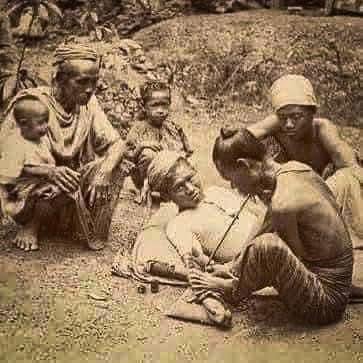
Sak Yants done by Monks and Sak Yant Ajarns
Through out the history of the Sak Yant Traditions you could only get a Sak Yant from a qualified Spiritual Master. The Master was either a Temple Monk or a village Shaman. Tattooing in Thailand was always for Magical protection and not as it is now days for fashion or a quick buck from Tourists.
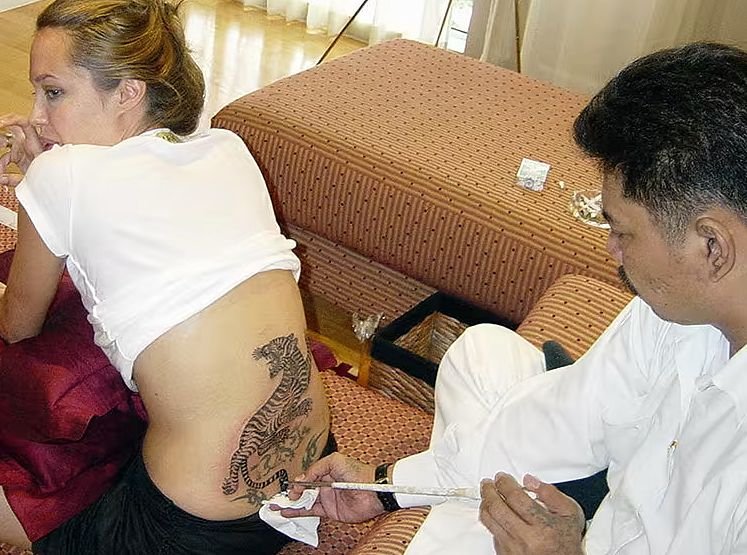
Jolie's Sak Yant Tattoo
Angelina got her first Sak Yant Tattoo. Western media mistakenly assumed that Thailand (like Philippines and Japan) used Bamboo to make their traditional Tattoos and referred to this as "Bamboo Tattoo". International Media and travel bloggers copied the incorrect "Bamboo Needle myth" which very soon became associated with the Sak Yant Hand Poke Tattoo Tradition

The Counterfeit Sak Yant Bamboo Needle Tattoo industry is created
With many tourist coming to Thailand and requested the same 'Bamboo Tattoo' that Angelina had. Tattoo Artists attached a machine needle to a chopstick or cut rod of bamboo and gave the tourists what they asked for. Tattoo Artists knew what they offered was an disrespectful 'copy' - but they made more money convincing Tourists that the design along with the Hand Poke method made their replicas special or traditional.
Bamboo Tattooing goes Mainstream
As Tourist demand for the unique appeal of Bamboo Tattoos continued, Thailand's Tattoo artists started teaching and promoting the hand poke tattooing skill to new Artists. Adding normal and non sacred designs they had always done with machines using the new 'bamboo tattoo method'. Here is when Tattoo Shops started to put the term Bamboo Tattoo, Traditional Thai Hand Poke style and enthusiastically promoted a false association with the traditions of the sacred Sak Yant
Why you don't get a Tourist Sak Yant Bamboo Needle Tattoos from a Tattoo Parlor
Many tattoo shop websites and even Google ads for their business promote Fake Sak Yant Bamboo Tattoo designs, catering to tourists. This is done despite the practice being frowned upon by Thai society, Sak Yant Masters and academics who do not support this tattoo parlor commercialization of their cultural heritage. These objections are rarely heard as
1) Sak Yant Masters prioritize spiritual practice over controversy, and remain silent
2) Scholars publish primarily in Thai language and in academic journals that do not get great results in Google.
Outside of tattoo shop promotions and travel bloggers that falsely link bamboo tattooing to Sak Yant traditions, the experts agree that such misrepresentations are highly disrespectful. Promvek and Chumnaseaw’s 2024 (7) study highlights tattooing as a significant part of Thai heritage but notes that foreign tourists often lack cultural awareness. “One thing that is of interest to foreign tourists is tattooing. Tattooing is an important cultural heritage that has been a part of Thai society for a long time and reflects one of the contexts of beliefs”.
The paper mentions international artists, such as Angelina Jolie, Brad Pitt, Anthony Bourdain and Ed Sheeran, receiving Thai tattoos, further fueling interest. “Thai tattooing has rapidly spread to foreigners. Famous foreign artists have continuously traveled to get Thai tattoos” The latest being 11 February 2024 Mr. Ed Sheeran, a British artist who loves tattoos gets a tattoo from Master Neng Kummantrarak”.
This article will explore why historians, scholars, and Sak Yant experts urge tourists to seek authentic Masters rather than commercial tattoo shops that mimic the design without any relevance to the Culture and traditions behind it. Go here to learn more about Why you don’t get a Sak Yant from as Tattoo Artist
1) The Importance of Sak Yant Tattoo in Thai Culture
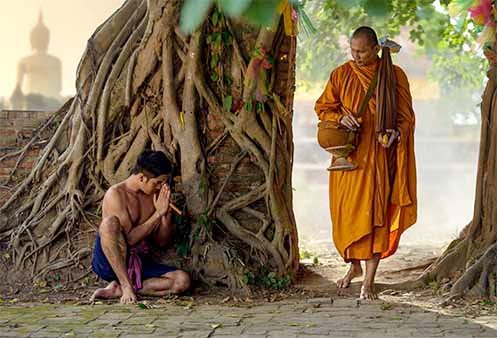 Sak Yant tattoos, also known as “Yantra tattoos,” are deeply embedded in Thai and broader Southeast Asian spiritual practices.(1)(3)(4). These tattoos are administered by Buddhist Monks or trained spiritual practitioners (Ajarns) using a hand-poked method with metal needles. The importance of Sak Yants only being done by qualified people is expressed in the National Geographic article (1) “In ancient times, most tattoo masters that people respected and believed in were mostly monks who were experts in the Pali language and various yantra, including spells. There were also some lay masters, but most of them had been ordained as monks and were skilled in (Magical) tattooing before”
Sak Yant tattoos, also known as “Yantra tattoos,” are deeply embedded in Thai and broader Southeast Asian spiritual practices.(1)(3)(4). These tattoos are administered by Buddhist Monks or trained spiritual practitioners (Ajarns) using a hand-poked method with metal needles. The importance of Sak Yants only being done by qualified people is expressed in the National Geographic article (1) “In ancient times, most tattoo masters that people respected and believed in were mostly monks who were experts in the Pali language and various yantra, including spells. There were also some lay masters, but most of them had been ordained as monks and were skilled in (Magical) tattooing before”
Each Sak Yant Tattoo design is imbued with specific meanings and is believed to offer protection, strength, and other blessings to the wearer. The process involves intricate rituals, including offerings and chants, culminating in a sacred blessing that activates the tattoo’s spiritual benefits (3). Nantchaya Mahakhan emphasis this by saying “In Thailand, tattooing is performed based on beliefs in magical powers, such as various mystical powers, magical powers, good fortune, kindness, popularity, longevity, charm, escaping danger, having skin that cannot be harmed by weapons, etc. The tattoo patterns are also performed for magical powers. Most of these tattoos are the heart of a spell that is strung together in various forms called Yantra or other sacred images used in tattooing for magical powers”
Tattooing is an important cultural heritage that has been a part of Thai society for a long time and reflects one of the contexts of beliefs in Thai society (10). The importance of the Sak Yant, it’s power and the dangers of incorrect application by those who are not qualified are understood by Thai people. This includes the Tattoo Artists who are forced to balance or reject their own respect for the culture, and the desire for an income when faced with numerous competitive business providing Tattooing
2) The Components of the Sak Yant Tattoo
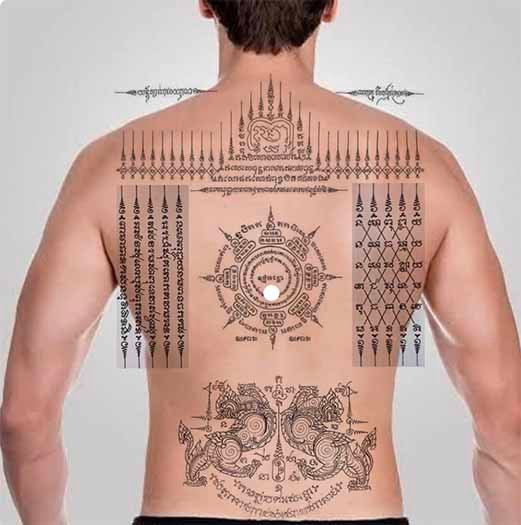
One of the best resources for Sak Yant Information in English is the Sak Yant Chiang Mai’s website. With the advantage of consulting many different Sak Yant Masters around the country it consolidates accurate knowledge in English. Sak Yant Chiang Mai report (9) there are 3 aspects that make a Sak Yant authentic, the 2 most important of the factors are missing in the fake Sak Yant designs made by tattoo shops.
The 3 aspects include
1) The Design (Picture)
2) The Khata (Text around the picture)
3) The Rituals and Blessing
Issue arise for the Tourist getting a Bamboo Tattoo, as almost every design a tattoo artists uses they download from online. Sak Yant Masters will not release true designs with correct magical spells because of the danger of attempting magic by the untrained which can cause bad luck and misfortune. The magical Khata is created freehand by Sak Yant Masters along with chanting of magical mantras as the design is created. “It is then pierced into the skin to create characters. pattern With the word “talisman” Which means character shape Khmer script is written according to the principles of Buddhism and in patterns based on beliefs”. (Liu, Q., 2565, p.8)
Tattoo Artists without any training in the ancient magical languages used in Sak Yant Tattoos will just copy the incorrect magical text used in their catalogs; or worse replica what the customer decides is the ‘cool looking tattoo they want’
The most widely emphasized aspect of the true Sak Yant is the importance of the Rituals and blessings. The key aspect of what makes a Sak Yant a Magical and authentic Traditional Thai Tattoo.
3) The Rituals and Magical Blessing - Devoid in Tourist Bamboo Tattoo Shops
The most important aspect of an authentic Sak Yant Tattoo, and something that no Tattoo artist can provide with their Tourist Sak Yant Bamboo Tattoo is … the rituals and blessings that make them not only prized in Thai Culture but also Spiritual. These include both the offering to the Sak Yant Master and receiving the blessing afterwards. In both historical and academic commentary about the Sak Yant, this is most clearly evident.
1 The Offering: Showing your respect to both the tradition of the Sak Yant and the expertise of the Master providing it
Thailand’s Nation geographic article on the topic says “The steps and methods of tattooing by Thai people, as observed from many temples and institutes, are mostly similar. The first important thing is “paying respect to the teacher.” Every person who will receive a tattoo must prepare a flower tray, incense, candles, money to pay respect to the teacher, and nowadays, there may be cigarettes or energy drinks, dedicating themselves to being a disciple of the tattoo master first.” (1).
This sentiment is repeated in every historical documents regarding the Sak Yant Tradition. “As for paying homage to the tattoo master of each institute, it is popular to do so during the 7th month (around April) on Phaya Wan day or the 9th month (around June). In the case of Chiang Mai, the tattoo institutes prefer to perform the paying homage to the master after the traditional ceremony of putting flowers in a bowl to worship the Inthakhin pillar in the 9th month is finished”(11). Although it is important to note that these specific dates suggestions applied when people lived in communities and had access to Masters. Something that all communities used to have in the past.
It is completely understood by all Thai People that the person who gets a tattoo must pay homage to the teacher by offering a flower tray, incense, candles, cigarettes, and money to pay homage to the tattoo master. In this act they are dedicating themselves as a disciple, and vowing to be a good person. After receiving the tattoo, the tattooing ceremony will begin.(1)
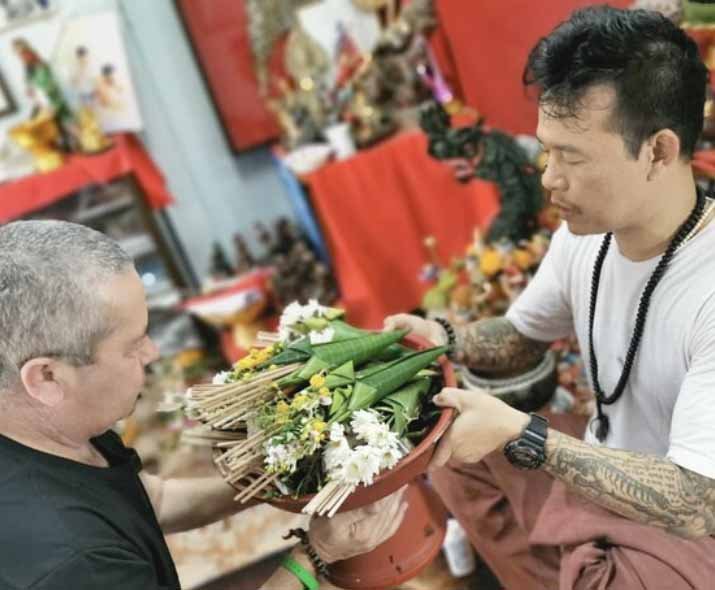

2 The Blessing: Activation of the Magical Text with Prayers and Mantra. Generally the Sak Yant Master will silently recite the magical mantra as they are creating the Traditional Thai Tattoo, and finalize it after completion to activate the mantras.
In the writings of Sak Yant instruction by two Monks (Phra Athikan Attharo and Phra Maha Wirot Kuttawiro, 2566) they say that the Master must “With the chanting of a spell, every time a yantra is tattooed, teachers and masters are required to protect and preserve. The person who gets the tattoo must have faith and devotion. Respect, obey and follow the teachings of teachers and must have morality. Practice according to the principles of Buddhist teachings”
With consistency in Sak Yant lore, the reciting of Mantra by the Sak Yant Master is also repeated by Monks Athit Attharo and Maha Wirot in their book ‘The Brave One’ (12) where they instruct “When inking a yantra, if the yantra has a mantra attached to it, then the mantra must be recited at the same time as inking the yantra. Therefore, a high level of concentration is required. As for the steps of inking the yantra, it will be done according to what has been learned from teachers who have imparted knowledge according to the guidelines of each school”.
After the completion of the Sak Yant – the Blessing is conducted verbally where the Sak Yant Master Blessed and activates the mantra they have been intentionally projecting into the Tattoo.
The silent reciting of mantra as the tattoo is inked requires not only concentration, but also the spiritual purity and respect for the Buddhist lifestyle. Anyone who has experienced getting a Tattoo in a Tattoo Shop, being allowed to play on their phones, while the tattooist chats with others, or listens to music as they preform the tattoo .. has experienced exactly the opposite of how a real Sak Yant is performed.
4) No such thing as a Bamboo Needle or Bamboo Tattoo
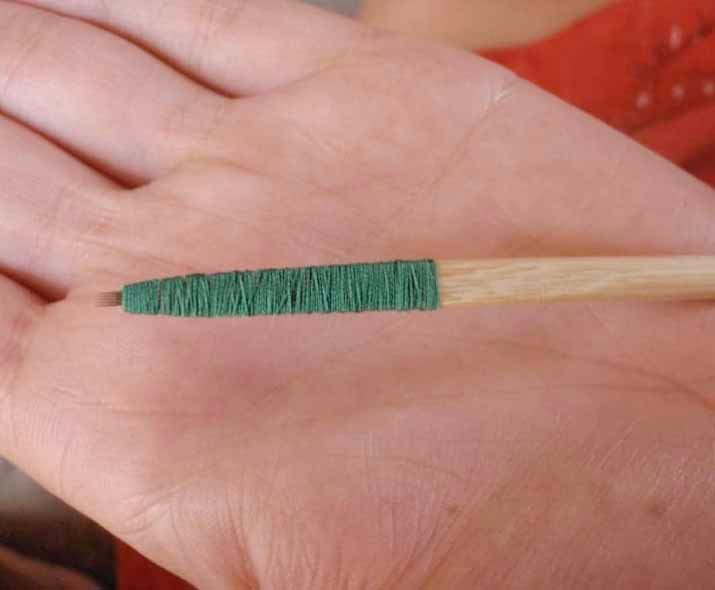
True History shows there is just no such thing as a bamboo Needle and thus a Bamboo Tattoo. Before the modern era of machine tattooing in Thailand, all previous traditional Thai tattoos were magical and spiritual hand poked talismans mostly done by Buddhist Monks. Buddhist Monks have always had access to refined metals that were used for statutes, bowls, and especially sacred devices like the Khem (Tattoo rod) and the needles (13).
Monks just had no need to use bamboo to make tattoos. Bamboo is too light to pierce the skin, to painful when used, caused splinters and didn’t hold ink within the split bamboo needle.
The only documented time a bamboo stick and bamboo needle has ever been used in Thailand is when prisoners wanted a tattoo and this was the only resource available to them (1). There are countless descriptions throughout historical documents that describe the process of Sak Yant Tattooing and all of them mention Steel or metal sacred tools and needles (6) (7) (2). This factual account of Sak Yants not using Bamboo for either the Needles or the Khem is a continuous theme as basic information at websites by true providers of the Sak Yant Tattoo (5) (14)
The only time a Bamboo stick will ever be used is to give it to the tourist afterwards as a souvenir. Holy men able to preform authentic Sak Yants would not freely give away their magical tools. This was only done when a student becomes a Master of Sak Yant after years of training.
The use of metal to perform traditional Thai Tattoos is often pointed out in academic studies. “Sak Yant tattooing can be divided into two parts. namely The word “tattoo” Refers to the use of a sharp iron rod” (7). In Tattoo Culture in Lanna (6) the author details under the method of tattooing “Sak Yant uses a sharp iron or brass object about 3 inches long connected to a wooden or metal handle, for a total length of about 30 – 50 centimeters, called “Lek Sam” or “Lek Jar”. The tip of the iron is sharp and has 2 halves joined together to hold ink, tattooing to a depth of about the thickness of 7 betel leaves stacked together”
5) The Tattoo Shop Intent to Deceive Tourists
It is important to note that not all of Thailand’s Tattoo Shops or Tattoo Artists will do this. A few Tattoo Artist will outright refuse to provide Sak Yant designs even though they will make normal tattoo designs using the hand poke method.
Some Tattoo artists will point out that they offer ‘Artistic replicas’ of the traditional Sak Yant design. Their websites point out, along with the benefits of having a replica rather than the real and authentic Sak Yant. Sadly however, many of Thailand’s tattoo parlors will either display the designs outside of their windows and leave it up to the customer to not research or realize the ‘Bamboo Tattoo” of traditional designs is not the same thing as a real Sak Yant. Some will even outright just lie, saying that they provide the real thing. You can find out methods of how Tattoo Shops deceive tourist and avoid them here
The question of ethics is part of the concern for those who appreciate the traditions and culture associated with authentic Sak Yants. What should be more concerning for the tourist, even if they just want a Tourist Bamboo Tattoo of a non sacred design, is
If a Tattoo artist who is blatantly disrespectful in their ethics to their Sacred Buddhist Culture - by making counterfeit Sak Yant Designs. Can you really trust their ethics when it comes to a tourist who will soon be returning to their home country never to be seen again?
- All
- Bamboo Tattoo
- Sak Yant Tattoo
- Tattoo Shop

Thailand Bamboo Tattoos Are Non-Existent in Thai Culture Western media made up the Thailand Bamboo Tattoo concept when they confused...

What to Do After Getting a Fake Sak Yant Receiving a Sak Yant tattoo is often considered a sacred and...

Why you Don’t get a Sak Yant from a Tattoo Artist Tattoo Shops in Thailand and regular Tattoo Artists can’t...
Academic and Historical References
(1). Thai Tattoos, the symbolic lines of faith National Geographic. Nov 4 2020. https://ngthai.com/cultures/31619/thai-traditional-tattoos
(2) Why you don’t Get a Bamboo Tattoo at a Tattoo Shop sakyantchiangmai.com Oct 2022 https://sakyantchiangmai.com/sak-yant-bamboo-tattoo/
(3) Study of Thai and Japanese Tattoo. 1996 Nantchaya Mahakhan Burapha University, Faculty of Humanities and Social Sciences https://buuir.buu.ac.th/xmlui/handle/1234567890/549
(4) Communication and Perception of the Meaning of ‘Tattoos’ in Contemporary Thai Society’, Faculty of Communication Arts, Chulalongkorn University, by Suksan Kamolsantiroj, 2005 https://cuir.car.chula.ac.th/handle/123456789/8025
(5) What is a Bamboo Tattoo. Sak Yant Chiang Mai 2023 https://sakyantchiangmai.com/bamboo-tattoo-thailand/
(6) Tattoo Culture in Lana Sept 6 2022. Princess Maha Chakri Sirindhorn Anthropology Centre. Phudech Saensa https://www.sac.or.th/portal/th/article/detail/371
(7). Sak Yant tattooing as Thai soft power. Department of Public Administration Faculty of Political Science Ramkhamhaeng University. Krissada Promvek. And Prachaya Chumnaseaw 2024. http://www.hurujournal.ru.ac.th/journals/35_1719810573.pdf
(8) Bamboo Tattoo Bangkok. Sak Yant Bangkok 2024. https://sakyant-bangkok.com/bamboo-tattoo-bangkok/
(9) What is a Sak Yant Tattoo. 2022 Sak Yant Chiang Mai https://sakyantchiangmai.com/what-is-a-sak-yant-tattoo/
(10) Pansa Khrueaklai and Noppadol Inchan, 2002, p. 73)
(11) Chuanphit Naphatasaai (editor), Dhammatharo Achariyanuson, (cited), page 49.
(12) Book The Brave One. (Phra Athit Attharo and Phra Maha Wirot , 2566)
(13) Tourist Bamboo Tattoo vs Real Sak Yant. Youtube Video https://www.youtube.com/watch?v=-HogMIhYYz8
(14) The Story of the Bamboo Tattoo Needle. Thai Tattoo Chiang Mai. https://thaitattoochiangmai.com/2016/08/28/bamboo-sak-yant-needles/
